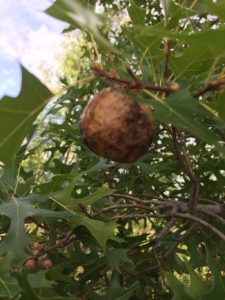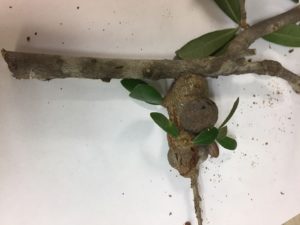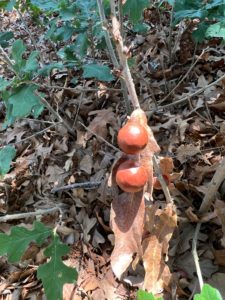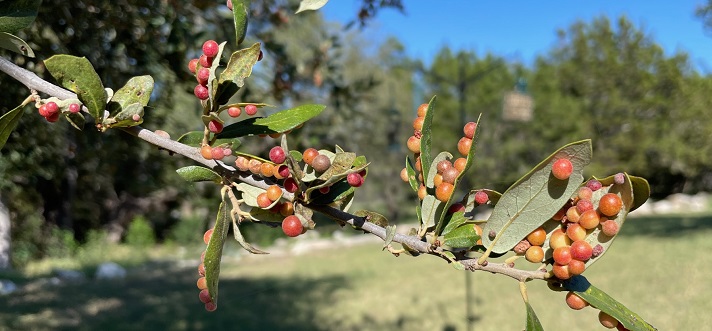Plant galls are fascinating to me. They are all around us, yet we seldom notice them unless they appear in a favorite landscape tree. Plant galls are produced by a variety of organisms which include mites, wasps, midges, thrips, fruit flies, moths, psyllids, and aphids, as well as bacteria and fungi. Most plant galls are not harmful to the host plant, with the exception of some formed by bacteria and fungi.
Many plant galls are produced by the host plant in response to the egg laying activity of the insects and mites mentioned. Either the mechanical effect of the egg laying, or the introduction of a chemical into the plant during the process causes accelerated production of plant growth hormones. Tiny wasps, the size of fruit flies, and tiny flies produce consistent forms of galls on the host plant, the mechanism of which has yet to be discovered!
Galls can form on roots, trunks, branches, buds, flowers, fruits, and leaves. Not all galls are harmful to plants. Some galls have been utilized in the tanning industry for their high content of tannic acid. Native Americans used specific galls as an eyewash for inflamed eyes, or as a treatment for burns and wounds. They have been used as a source of dye for wool and leather, and even as a source of ink used by the United States Treasury and the Bank of England. Many important treaties were signed with ink made from galls, including the treaty with Japan formally ending WW II.
I’d like to share some of the common galls found on trees in Central Texas with you and encourage you to pay attention to the vegetation around you to see what other galls you may find. Please send photos to info@backbonevalleynursery.com and I will add new types of galls to this list for all to enjoy!

This is an Oak Apple Gall. It is found on native Spanish Oaks, aka Texas Red Oaks in Central Texas, as well as on Shumard Red Oaks. It is caused by a tiny cynipid wasp called an Oak Apple Wasp.

When the gall is cut open, you can see the radial fibers that support the larval chamber in the center. You may find an exit hole where the adult wasp, which developed from the larvae, emerged. These galls may remain on a tree for several years, and while it may look like the tree has been infested, there are most likely many generations of galls present.

This gall is found on the undersides of Live Oak leaves. It is called a Wooly Oak gall. It is also caused by a species of cynipid wasp called the Wool-bearing Gall Wasp.

This is one of the most common galls found on Live Oak trees in Central Texas. You may find them on the ground and wonder where these hard, marble-sized balls came from. They are called Mealy Oak Galls and they, too are caused by a tiny wasp. The galls may stay attached to the tree for many years after the adult wasp has left the gall. You can see the exit hole where the adult insect emerged.

Another species of cynipid wasp causes these colorful galls on the leaves of oaks.

I found these galls on a Scrub White Oak. Yet to be identified!

This is an example of a harmful gall. This Crown Gall is caused by a bacteria, Agrobacterium tumefasciens. It affects many trees and is especially harmful in fruit orchards.

Some insects cause galls to form on stems, such as these stem galls on Live Oak. They may restrict the flow of water and nutrients and damage the tree, or they may be harmless.

This is a leaf gall on a Texas Persimmon tree. I have seen them so prolific that they defoliate the tree, but that is not common and rarely harms the tree.
I hope you’ve enjoyed learning about these galls. Since most of these galls are harmless, there is no need to treat for them. It would be difficult to do, as you would have to know the life cycle of the specific insect that causes them and treat for them at exactly the right time. Please share your photos of galls with us, and I will add them to this post for others to see.





Leave A Comment